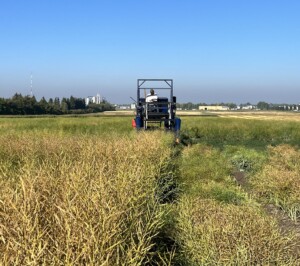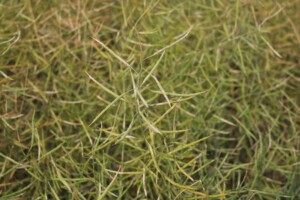
 By Anitha Chirumamilla and Bryan Hanson
By Anitha Chirumamilla and Bryan Hanson
Growing a great canola crop is one thing but being able to bring every pod and seed into the bin is equally important and challenging every year. Growing canola in the northern region with a shorter growing season comes with the advantage of cooler weather which boosts yields, but it also has the catch of unpredictable weather at the end of the season, making harvesting inconvenient and challenging at times. Pod shattering losses are a great concern to every farmer during this period. Some of the conditions that lead to seed loss due to shattering are discussed below.
Time and Method of Harvesting

Swathing canola trials at the Langdon Research Extension Center (LREC). Photo by Lawrence Henry, LREC.
For a crop that matures from the bottom to top, it is tricky to decide the time of harvesting. Canola harvested or swathed at the right maturity will result in improved seed quality with fewer green seeds, while delayed harvesting can lead to shattering losses and poor seed quality. To determine when a field of canola is ready to swath, examine plants from different parts of the field. When examining them, consider varying soil types, low-lying areas, available soil moisture and exposed early ripening areas. Seeds with only small patches of color should be counted as changed. The color of the seed is more important than the overall color of the field in determining the stage of maturity.
Canola can be swathed and combined or can be straight-combined. Producers traditionally have swathed. In recent years, the availability of new pod shatter-resistant varieties has made straight-cutting the new trend for canola harvesting. However, based on the conditions available for harvesting, both swathing and straight-combining have their places. Heavier canola stands are better suited for straight-combining compared to thinner stands, which are more susceptible to the likelihood of shattering from wind. On the other hand, in the absence of pod shatter tolerance, swathing is recommended over straight-combining to prevent yield losses by as much as 8 to 54 % (as reported by the Canola Production Center in Canada). These losses are primarily due to preharvest shattering and gathering shattering losses when canola was taken into the combine.

Canola pods turning white from feeding damage of diamondback moth larvae. Photo by Anitha Chirumamilla, LREC.
Hail Events
Hail events at different stages of canola growth can lead to various levels of injuries and yield losses. Direct seed yield loss occurs when the injury occurs at the ripening stage, leading to loss of branches, individual pods and seed knocked out of pods. Severe hail losses have also occurred in canola swaths, with excessive shattering of pods causing economic seed loss.
Insect Damage
Canola is attacked by various insects that cause yield losses due to their direct feeding damage on the plant parts such as leaves, flowers, pods and seeds. Among them, insects such as diamondback moth and bertha army worm are also known to contribute to indirect damage like shatter losses in canola. This is caused by larvae of these insects feeding on the pods by scraping or chewing, weakening the pods and leading to premature shattering. Timely scouting and management of insect problems can prevent seed loss due to shattering.
Anitha Chirumamilla and Bryan Hanson are Extension Cropping Systems Specialist and Research Agronomist, respectively, at the Langdon Research Extension Center of North Dakota State University.